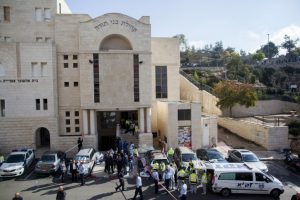I totally agree with your assessment. from the perspective of the media. I would say, however, that many among us also share your feelings and are trying to still grapple with the “new world” we live in. With what has transpired, in Israel and throughout the world, eulogies are still being delivered and much talk and soul-searching is taking place.
I received a posting from a close student of mine, a recent convert to Judaism about the Har Nof synagogue attack, which I found very touching and could, perhaps, provide some insight into how we should think of changing our world in light of all the horrific events of recent times. I would like to share it with you (I replaced many of the Yiddish and Hebrew words he used to English for the benefit of all readers):
“Ever since our holy ones were slaughtered in Har Nof while praying the silent Amida Prayer, I think of them and try my best to pray in their place; as close to the way they would want to pray. When we put our tallis over our heads, I think what a spiritual tent these are, quite far beyond what crazed Islamists can slice through; and I think what a tent we can be for everyone, what a tent our holy ones who lost their lives would want to be, just like our patriarch and matriarch Avraham and Sarah, had they not been snatched away. When we lay tefillin on our arms and heads I think what spiritual bands of strength they are, quite far beyond anything crazed Islamists can do anything about, because they can’t touch or hinder the motivation our holy ones who lost their lives have shown us, to carry on in defense of not only ourselves, Klal Yisroel, but every righteous gentile out there, as well. Every leopard, eagle, tree, flower, rock, and puddle; everything that exists in the world. When we recite the nineteen holy b’rachos of the silent Amida, every one of them reads like pure gold; everyone would be ~ Heaven forbid ~ cherished last words; and I recite them knowing that they and the Sh’ma were the cherished last words of our Kedoshim, our holy ones who were martyred. And when we receite Tachanun (a prayer addressing the problems of the Jews), there’s nothing but to cry when we beseech the Holy One, blessed be He, to keep us in His Hands and not let us fall into the hands of men (as the prayer states). It may seem like our martyred Kedoshim did fall into the hands of men except that we know the Ribono Shel Olam, the Master of the Universe, would never loosen His hold on us. Our neshamos (souls) and those of our martyred Kedoshim continue untouchable by any men. Am Yisroel Chai. My name is in the middle, and my mind and heart and holy neshama are in the middle, too.”
–Yisroel Simcha Y.S.
I think that if we all would follow in these footsteps and strive to live up to the holiness of those men snatched from us, we could provide some meaning to their loss and make up, even a drop, of what was lost. There are so many areas needing improvement, especially the way we act towards each other, Torah study and more that we could all do that would be a Tikkun to the world and bring a positive merit to the memory of these holy martyred Jews.
Sincerely,
Rabbi Yerachmiel Fried


